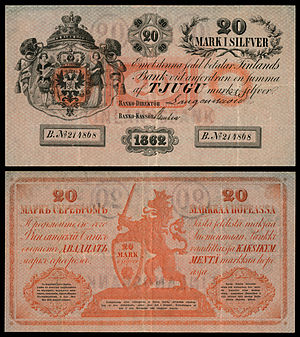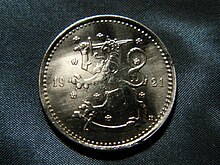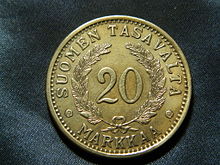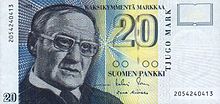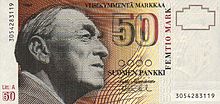
The peseta was the currency of Spain between 1868 and 2002. Along with the French franc, it was also a de facto currency used in Andorra.

The krone is the official currency of Denmark, Greenland, and the Faroe Islands, introduced on 1 January 1875. Both the ISO code "DKK" and currency sign "kr." are in common use; the former precedes the value, the latter in some contexts follows it. The currency is sometimes referred to as the Danish crown in English, since krone literally means crown. Krone coins have been minted in Denmark since the 17th century.
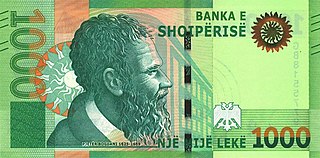
The lek is the currency of Albania. Historically, it was subdivided into 100 qintars.

The lev is the currency of Bulgaria. In old Bulgarian, the word "lev" meant "lion"; the word "lion" in the modern language is lаv. The lev is divided in 100 stotinki. Stotinka in Bulgarian means "a hundredth" and in fact is a translation of the French term "centime." Grammatically, the word "stotinka" comes from the word "sto".

Sterling is the currency of the United Kingdom and nine of its associated territories. The pound is the main unit of sterling, and the word pound is also used to refer to the British currency generally, often qualified in international contexts as the British pound or the pound sterling.

The Portuguese escudo was the currency of Portugal from 22 May 1911 until the introduction of the euro on 1 January 2002. The escudo was subdivided into 100 centavos. The word escudo derives from the scutum shield.

The franc, also commonly distinguished as the French franc (FF), was a currency of France. Between 1360 and 1641, it was the name of coins worth 1 livre tournois and it remained in common parlance as a term for this amount of money. It was reintroduced in 1795. After two centuries of inflation, it was redenominated in 1960, with each new franc (NF) being worth 100 old francs. The NF designation was continued for a few years before the currency returned to being simply the franc. Many French residents, though, continued to quote prices of especially expensive items in terms of the old franc, up to and even after the introduction of the euro in 2002. The French franc was a commonly held international reserve currency of reference in the 19th and 20th centuries. Between 1998 and 2002, the conversion of francs to euros was carried out at a rate of 6.55957 francs to 1 euro.
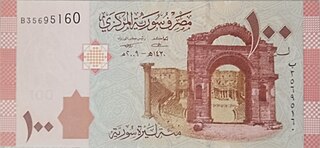
The Syrian pound or lira is the currency of Syria. It is issued by the Central Bank of Syria. The pound is nominally divided into 100 piastres, although piastre coins are no longer issued. All banknotes and coins below 50 pounds are practically worthless by Dec 2022.

The Sri Lankan Rupee is the currency of Sri Lanka. It is subdivided into 100 cents, but cents are rarely seen in circulation due to its low value. It is issued by the Central Bank of Sri Lanka. The abbreviation Re (singular) and Rs (plural) is generally used, the World Bank suggests SL Rs as a fully disambiguating abbreviation for distinction from other currencies named "rupee".

The lira was the currency of Italy between 1861 and 2002. It was introduced by the Napoleonic Kingdom of Italy in 1807 at par with the French franc, and was subsequently adopted by the different states that would eventually form the Kingdom of Italy in 1861. It was subdivided into 100 centesimi, which means "hundredths" or "cents". The lira was also the currency of the Albanian Kingdom from 1941 to 1943.
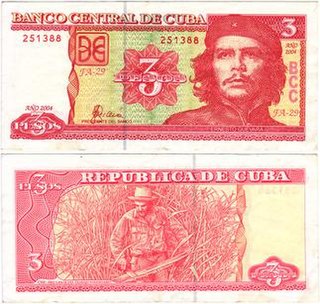
The Cuban peso also known as moneda nacional, is the official currency of Cuba.

The Egyptian pound is the official currency of Egypt. It is divided into 100 piastres, or qirsh, or 1,000 milliemes, but milliemes are no longer used.

The Belgian franc was the currency of the Kingdom of Belgium from 1832 until 2002 when the Euro was introduced. It was subdivided into 100 subunits, each known as a centiem in Dutch, centime in French or a Centime in German.
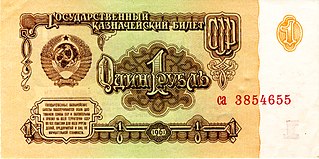
The ruble or rouble was the currency of the Soviet Union. It was introduced in 1922 and replaced the Imperial Russian ruble. One ruble was divided into 100 kopecks. Soviet banknotes and coins were produced by the Federal State Unitary Enterprise in Moscow and Leningrad.

The Djiboutian franc is the currency of Djibouti. Its ISO 4217 currency code is DJF. Historically, it was subdivided into 100 centimes.
The Slovak koruna or Slovak crown was the currency of Slovakia between 8 February 1993 and 31 December 2008, and could be used for cash payment until 16 January 2009. The ISO 4217 code was SKK and the local abbreviation was Sk. The koruna was subdivided into 100 haliers. The abbreviation is placed after the numeric value.
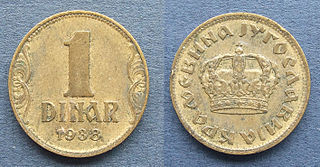
The dinar was the currency of Yugoslavia. It was introduced in 1920 in the Kingdom of Serbs, Croats and Slovenes, which was replaced by the Kingdom of Yugoslavia, and then the Socialist Federal Republic of Yugoslavia. The dinar was subdivided into 100 para.

The first official currency of Brazil was the real, with the symbol Rs$. As the currency of the Portuguese empire, it was in use in Brazil from the earliest days of the colonial period, and remained in use until 1942, when it was replaced by the cruzeiro.
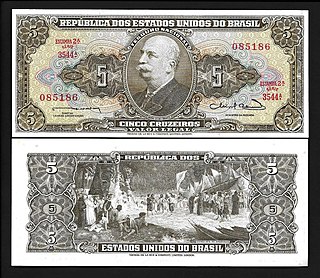
The (first) cruzeiro was the official currency of Brazil from 1942 to 1967. It replaced the old real, which had been in use since colonial times, at the rate of Rs 1$000 = Cr$1, It was in turn replaced by the cruzeiro novo, at the rate of Cr$1,000 = NCr$1.

The drachma was the official currency of modern Greece from 1832 until the launch of the euro in 2001.

